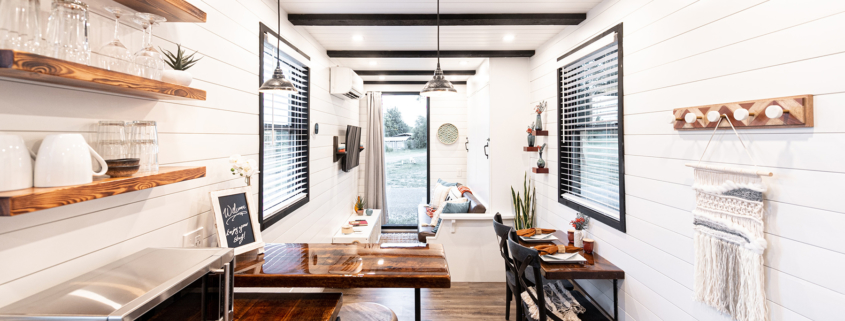Tiny Home Insurance – Yes, You Should Have It!
Want to downsize? If you choose to live in a tiny house, make sure your property and belongings are protected with tiny home insurance!
With the popularity of tiny homes over recent years, and particularly during an ongoing, stressful, and costly pandemic, it inspires for many a move to downsize and simplify.
But, there’s a lot to consider if you’re pondering a tiny home as a solution to your downsizing needs. Throughout British Columbia, in many, if not most, communities, what constitutes tiny home living is still a question.
But, with the popularity of tiny homes, there’s been a change in attitude and bylaw when it comes to tiny home living. More than just a solution for those wanting to simplify, tiny homes offer one answer to the problem of housing affordability for many districts and municipalities throughout the province.
And, just because your home may be tiny, it doesn’t mean it should go uninsured. Any dwelling should be protected in the event of fire, water damage, or other circumstance that causes damage or loss. And while it’s not officially referred to as “tiny home insurance”, insuring your smaller or tiny home must be on your radar as you make your plans to significantly reduce your housing footprint.
What constitutes a tiny home?
If you’ve been living under a rock, or have not tuned into HGTV over the past several years, you may not be familiar with the tiny home. Beyond making the simple connection with the name!
A tiny home is very small. Typically they are no larger than 500 square feet – pretty small! They’re constructed using a variety of different materials and methods and material, from stick-built to steel shipping containers. They are often mobile – built on a trailer or wheels – and can be easily moved.
A tiny home can still contain living and dining areas, a kitchen, a sleeping area and bathroom – with laundry! – and is intended for full-time, year-round living. Cottages, campers, recreational vehicles, and any other seasonal dwelling is not considered a tiny home.
Small and very economical, it’s no surprise that they’ve gained traction among homeowners who want sustainability and efficiency in their day-to-day living, including utilities costs and environmental impact.
The COVID-19 pandemic has accelerated the desire to buy a tiny home. According to a report from Narcity, searches for ‘tiny homes for sale,’ have seen a 55% increase since the beginning of the pandemic.
What is the investment in a tiny home?
While small, don’t assume a tiny home will be cheap. Either to build or to buy. Costs can vary quite significantly to build a tiny house, from $60,000 to well over $100,000, depending on where you are, the builder you hire, and the materials you use.
Again, depending on where you are, tiny homes can list for anywhere from $40,000 to almost $200,000. Still much lower than current average home prices across the province.
Considerations for tiny home insurance coverage
Yes, you’re considering a tiny house to save money and simplify your life, but tiny home insurance should still be part of that picture. Particularly, if it’s valued into the mid to high 5-figures or well into 6-figures. It is an asset that is high-worth that you’ll want to protect.
In the event of major damage, like that from a fire, for example, it could cost you many thousands of dollars to repair or rebuild, as with a larger home. That is where the right home insurance policy, even for your tiny house, will be very helpful.
With the appropriate policy, if and when you experience major damage to your tiny house – fire, water leak, extreme snow load, exceptionally strong wind – your property is covered. It’s valuable coverage that can help pay for the necessary repairs, or even replacing your home, if required.
Even in your tiny home, you’ve invested significantly. Don’t risk losing that investment.
Building or buying a tiny home? What you should know
First, you need to explore your local zoning by-laws and regulations in your municipality or regional district. Before making any decisions or spending any money, be sure you understand fully any specifics – size requirements, if a foundation is required, building codes, etc.
Consult with your governing bodies prior to putting a tiny house on your property.
Be aware of the following:
- Size requirements
- Necessary building permits
- Designing and building to comply with Building Code
- Any municipal zoning that applies to your property
- If building inspections are required during construction
Home insurance for a tiny house
As with any house, a tiny home is vulnerable to risk. Be sure to speak with your insurance agent to ensure that it’s eligible to be insured. Below is a bit of a checklist to see if your tiny house qualifies:
- It is permanently parked or on a fixed foundation.
- It is skirted – has underpinning that wraps around the base of a mobile, manufactured, or tiny home to enclose the crawl space beneath.
- It complies with local standards or certifications.
- Passed the Canadian Standards Association standard.
Before you invest in a tiny home, do your research! Consult your insurance agent to ask questions and learn more about insurance for your tiny home. Contact us today!



